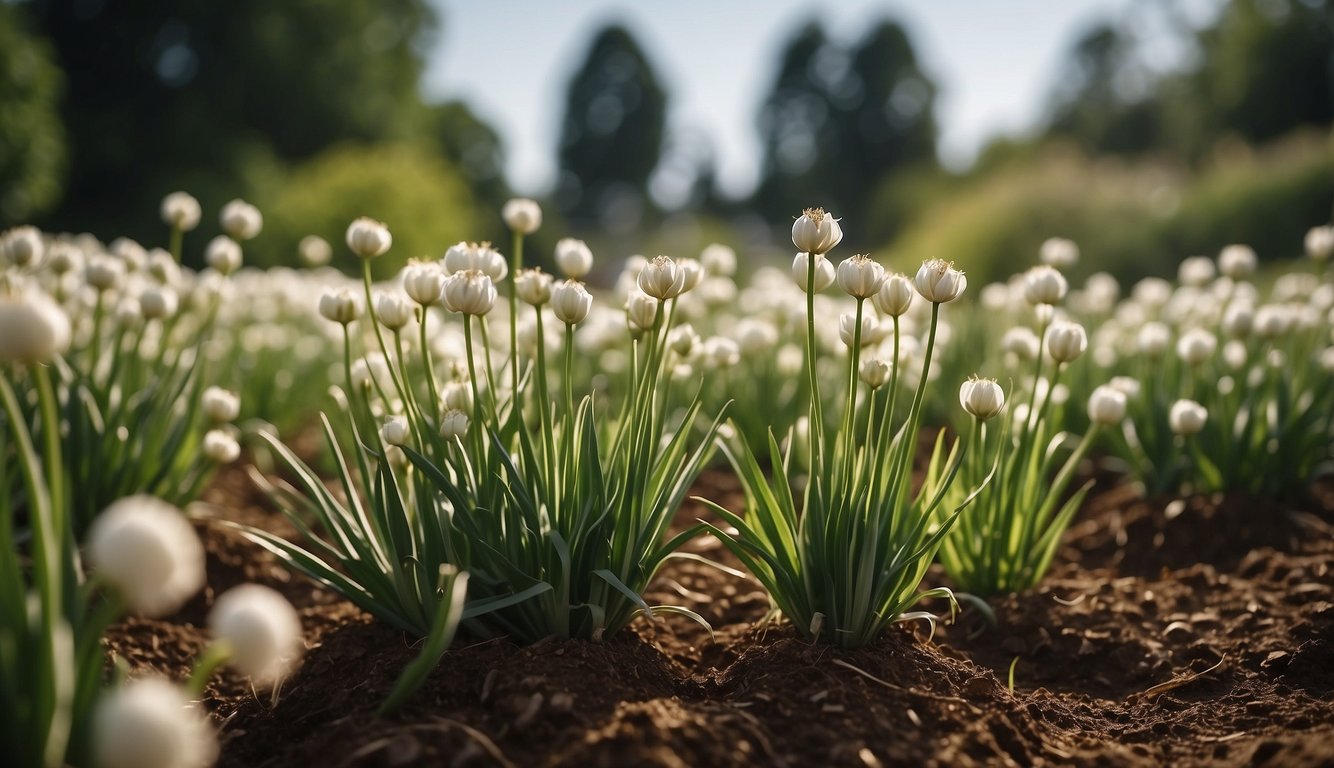TheHerbProf.com is a treasure trove of knowledge for those interested in natural healing and herbal remedies. The website is run by Paul Johnston MD. A naturopathic who has not only received extensive education in the field but also has personal experience in self-healing.
Garlic is a must-have ingredient in any kitchen, and it’s surprisingly easy to grow in your own backyard. A garlic garden is a great addition to any vegetable garden, and it can provide you with fresh garlic year-round. Whether you’re a seasoned gardener or a beginner, growing garlic is a rewarding experience that doesn’t require a lot of time or effort.
Garlic (Allium sativum) is a member of the onion family and has been used for both culinary and medicinal purposes for thousands of years. It’s a hardy plant that can grow in a variety of climates, and it’s resistant to pests and diseases. Garlic is usually planted in the fall and harvested in the summer, and each bulb can produce up to 20 cloves. If you’re looking for a low-maintenance crop that can add flavor to your meals and boost your health, a garlic garden is the way to go.
Understanding Garlic
Garlic is a versatile and flavorful vegetable that is used in many cuisines around the world. In this section, I will provide an overview of garlic, including its botanical profile, nutritional and culinary use, and the different garlic varieties.
Garlic Varieties
There are many different types of garlic, including softneck, hardneck, and elephant garlic. Softneck garlic is the most common type and is often used in commercial garlic production. Hardneck garlic is known for its strong flavor and is often used in gourmet cooking. Elephant garlic is not a true garlic, but rather a member of the leek family. It has a milder flavor than traditional garlic and is often used as a substitute in recipes.
Some popular garlic varieties include ‘Chesnok Red’, ‘Inchelium Red’, Rocambole, Silverskin, Porcelain, and Artichoke. Each variety has its own unique flavor and characteristics, making them suitable for different culinary uses.
Botanical Profile
Garlic, also known as Allium sativum, is a perennial bulb that belongs to the Allium family. It is grown for its flavorful bulbs, which are made up of individual cloves. Garlic is easy to grow and can be planted in both the spring and fall.
Garlic is known for its long, green shoots, called scapes, which emerge from the bulb in the spring. These scapes are edible and have a mild garlic flavor. The bulb is harvested in the summer when the leaves begin to yellow and wilt.
Nutritional and Culinary Use
Garlic is a nutrient-dense vegetable that is low in calories and high in vitamins and minerals. It is a good source of vitamin C, vitamin B6, and manganese. Garlic is also rich in antioxidants, which can help protect against chronic diseases.
Garlic has a mild flavor when raw, but becomes sweet and nutty when roasted. It is often used to add flavor to dishes such as pizza, pasta, and pesto. Garlic can also be used as a seasoning for meat and vegetables, or as a spread for bread.
Garlic is a versatile vegetable that is easy to grow and has many culinary uses. With its mild flavor and many health benefits, garlic is a great addition to any diet.
Preparation for Planting A Garlic Garden
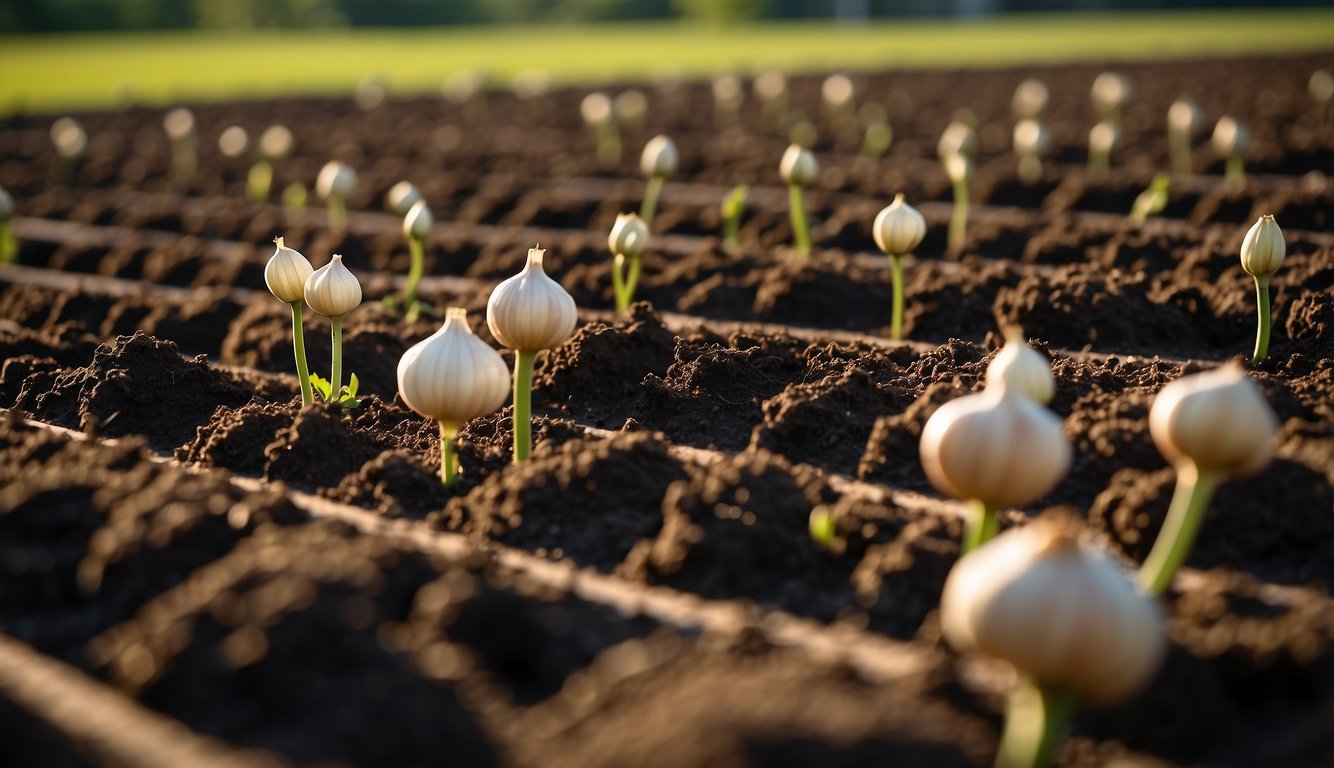
Garlic is an easy-to-grow crop that requires minimal effort, but proper preparation is essential for a successful harvest. In this section, I will guide you through the necessary steps for preparing your garden bed for planting garlic.
Choosing the Right Site
Garlic can be planted in both spring and fall, but fall is the preferred time to plant. Garlic requires full sun to grow and develop properly, so choose a planting site that receives at least six hours of direct sunlight each day. Also, consider the microclimate of your garden as garlic prefers a cool environment.
Soil Preparation
Garlic grows best in well-drained soil with a pH range of 6.0 to 7.0. Before planting, prepare your soil by removing any weeds, rocks, or debris. Work the soil to a depth of 4 inches using a garden rake or hoe. Enrich the soil with compost to add nutrients that will help the garlic grow strong and healthy. Garlic is a heavy feeder that needs plenty of nutrition to grow big flavorful bulbs. Prepare the fall soil with a generous heaping of compost and/or a slow-release organic nitrogen fertilizer such as feather meal.
Selecting Quality Seed For Garlic Garden
Selecting high-quality seed garlic is crucial for a successful garlic harvest. Choose large cloves from healthy bulbs that are free from disease or damage. Large cloves will produce larger bulbs, while small cloves will produce smaller bulbs. Ensure that the seed garlic you select is suited to your soil type and climate.
In summary, to prepare your garden bed for planting garlic, select a planting site that receives full sun and has a cool microclimate, prepare the soil by removing debris, adding compost, and slow-release fertilizer, and select high-quality seed garlic that is suited to your soil type and climate. With proper preparation, you can expect a bountiful harvest of delicious garlic.
Garlic Garden Planting Process
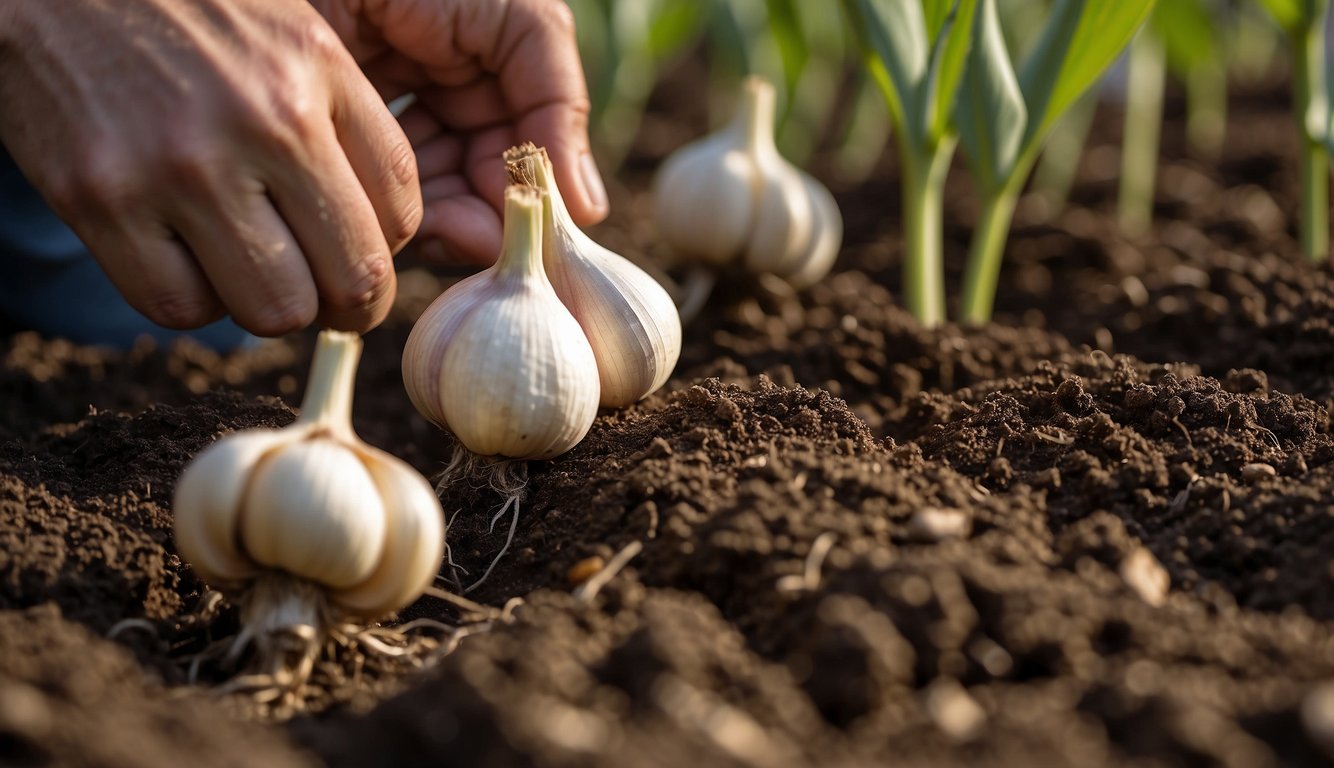
When to Plant Garlic Garden
I know that garlic is typically planted in the fall, about 4-6 weeks before the first frost. This allows the garlic to establish roots before the winter sets in. Hardneck garlic is best planted in cooler climates, while softneck garlic is better suited for warmer climates.
How to Plant Garlic
To plant garlic, I start by breaking apart the garlic bulbs into individual cloves. I make sure to choose the largest and healthiest cloves for planting. I then plant the cloves about 2-3 inches deep and 6 inches apart, with the pointed end facing up. Also, I cover the cloves with soil and lightly pat it down.
Watering and Fertilization
After planting, I water the garlic well and then mulch the bed with straw or leaves to help retain moisture and regulate soil temperature. Garlic needs consistent moisture, especially during the growing season. I water my garlic once a week, making sure to avoid getting water on the leaves to prevent fungal diseases.
When it comes to fertilization, I prefer to use organic fertilizers like bone meal or compost. Garlic needs nitrogen to grow, so I make sure to add a nitrogen-rich fertilizer before planting and then again in the spring before the garlic starts to grow actively.
Overall, planting garlic is a straightforward process. By planting at the right time, spacing the cloves correctly, and providing adequate water and nutrients, I can ensure a healthy and bountiful harvest of delicious garlic bulbs.
Garlic Growth Cycle
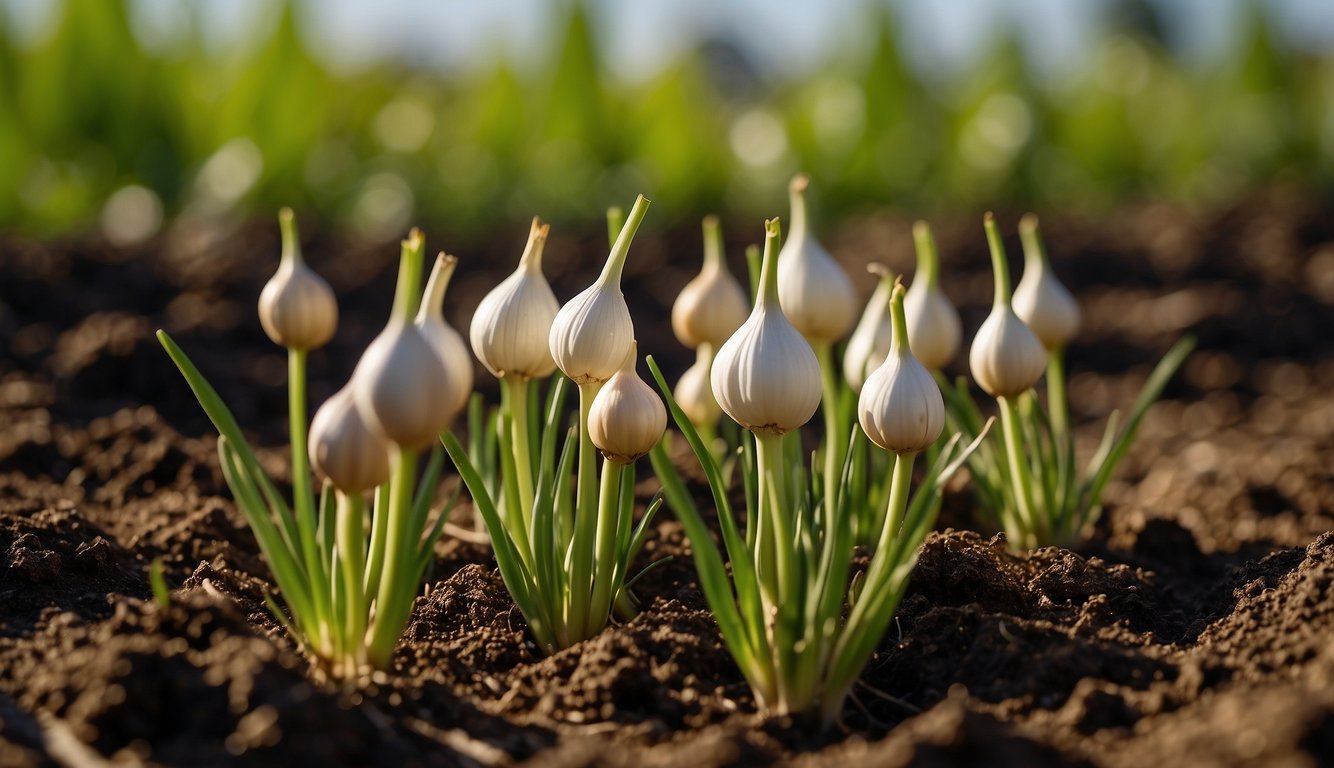
Growing garlic is a rewarding experience for gardeners. It is a hardy vegetable that is easy to grow and maintain. Garlic has a distinct growth cycle that is divided into several stages. In this section, I will discuss the garlic growth cycle, from sprouting to bulbing, managing pests and diseases, and climate and seasonal impact.
From Sprouting to Bulbing
Garlic is typically grown from cloves. The cloves are planted in the soil with the pointed end facing up and the root end facing down. After planting, the garlic will begin to sprout within a few weeks. The sprouts will grow into green shoots that will eventually turn yellow and die off.
As the green shoots die off, the garlic will begin to focus its energy on bulb formation. This is the most crucial stage of the garlic growth cycle. During this stage, it is important to ensure that the garlic receives enough water and nutrients. The bulbs will continue to grow until they are ready for harvest.
Managing Pests and Diseases In Garlic Garden
Garlic is susceptible to pests and diseases, such as aphids and white rot. It is important to monitor the garlic plants regularly and take action if any signs of pests or diseases are present. One way to prevent pests and diseases is to practice crop rotation. This means that you should not plant garlic in the same spot for several years in a row.
Another way to prevent pests and diseases is to keep the garlic plants healthy. This can be achieved by ensuring that the plants receive enough water and nutrients. Additionally, you can use organic pesticides to control pests and diseases.
Climate and Seasonal Impact
The climate and seasonal impact can have a significant effect on the garlic growth cycle. Garlic grows best in cool temperatures and requires a period of cold weather to develop properly. It is important to plant garlic in the fall, so that it can establish roots before the winter sets in.
During the summer months, it is important to keep the garlic plants well-watered and protected from extreme heat. High temperatures and humidity can cause the garlic to rot or develop fungal diseases.
Understanding the garlic growth cycle is essential to growing healthy and flavorful garlic. By following the proper planting and maintenance techniques, you can ensure a bountiful harvest of this delicious vegetable.
Garlic Garden Harvesting and Curing
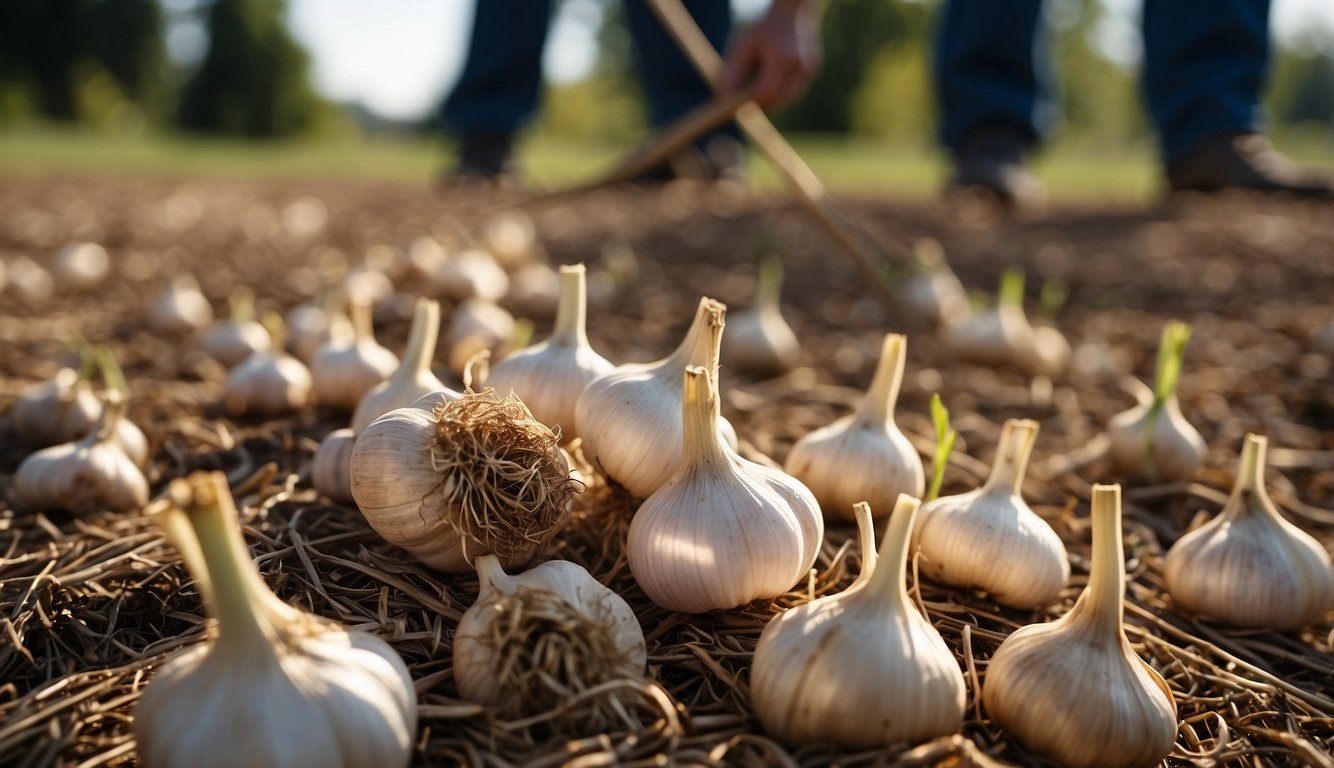
I know the importance of proper harvesting and curing techniques to ensure a bountiful yield of flavorful garlic bulbs. In this section, I will share my knowledge on how to identify maturity, how to harvest garlic, and how to cure and store garlic bulbs.
Identifying Maturity
The first step in harvesting garlic is to identify when the bulbs are mature and ready for harvest. Garlic bulbs can take anywhere from 90 to 150 days to mature depending on the variety and growing conditions. A good rule of thumb is to wait until the lower leaves turn brown and start to dry out, while the upper leaves are still green. Another way to check for maturity is to gently dig up a bulb and check for plump cloves that fill out the bulb.
How to Harvest A Garlic Garden
Once you have identified that your garlic is mature, it’s time to harvest. To avoid damaging the bulbs, use a garden fork to gently loosen the soil around the bulbs. Be careful not to pierce or bruise the garlic bulbs as this can lead to rotting during the curing process. Once the bulbs are loosened, gently pull them out of the soil by the stem.
Curing and Storage
After harvesting, it’s important to cure the garlic bulbs to ensure they last longer in storage. Curing allows the garlic to dry out and develop a protective layer around the bulbs, which prevents them from rotting. To cure garlic, hang the bulbs in a dry, well-ventilated area out of direct sunlight for 2-3 weeks. Be sure to leave the stems and roots intact while curing.
Once the garlic is fully cured, clean it up by removing the leaves at the neck and trimming the roots to 1/4 inch or 1/2 inch long. More dirt will dislodge and a couple of layers of bulb wrappers may flake off, giving you a nice and neatly packaged bulb. Store the garlic bulbs in a cool, dry, and dark place with good air circulation, such as a pantry or a root cellar. Avoid storing garlic bulbs in the refrigerator as this can cause them to sprout prematurely.
By following these simple steps, you can ensure a bountiful harvest of flavorful garlic bulbs that will last for months in storage.
Companion Planting and Rotation
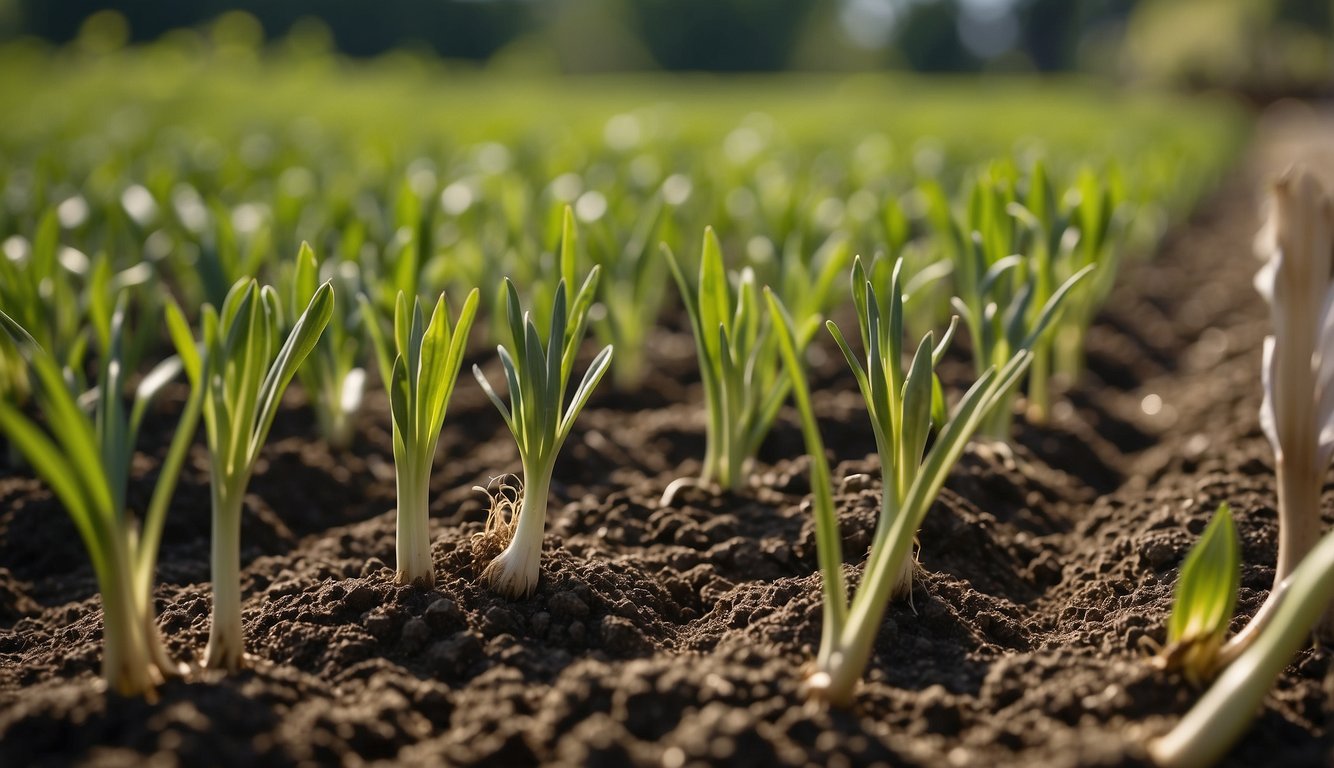
I know that planting garlic is just the first step towards a successful garlic garden. Companion planting and crop rotation are important techniques that can help to ensure a bountiful harvest.
Beneficial Companions
Companion planting involves planting different plants together that have a mutually beneficial relationship. Garlic has several beneficial companions, including spinach, carrots, shallots, chives, leeks, onions, and potatoes. These plants help to deter pests, improve soil health, and enhance the flavor of garlic.
Spinach, for example, is a great companion for garlic because it helps to repel pests such as aphids and spider mites. Carrots and shallots also help to deter pests, while chives and leeks help to improve soil health by adding nutrients and deterring harmful fungi.
Crop Rotation
Crop rotation is another important technique that can help to prevent the buildup of pests and diseases in the soil. It involves planting different crops in different areas of the garden each year. This helps to ensure that the soil remains healthy and productive.
When it comes to garlic, it is important to rotate it with other crops such as tomatoes, peppers, and beans. These crops help to add nutrients to the soil and deter pests that can harm garlic.
In addition to companion planting and crop rotation, it is important to pay attention to growing conditions such as sun exposure and soil temperature. Garlic thrives in full sun and well-drained soil with a pH between 6.0 and 7.0. By following these tips, gardeners can ensure a successful garlic garden year after year.
Garlic Garden Regional Considerations
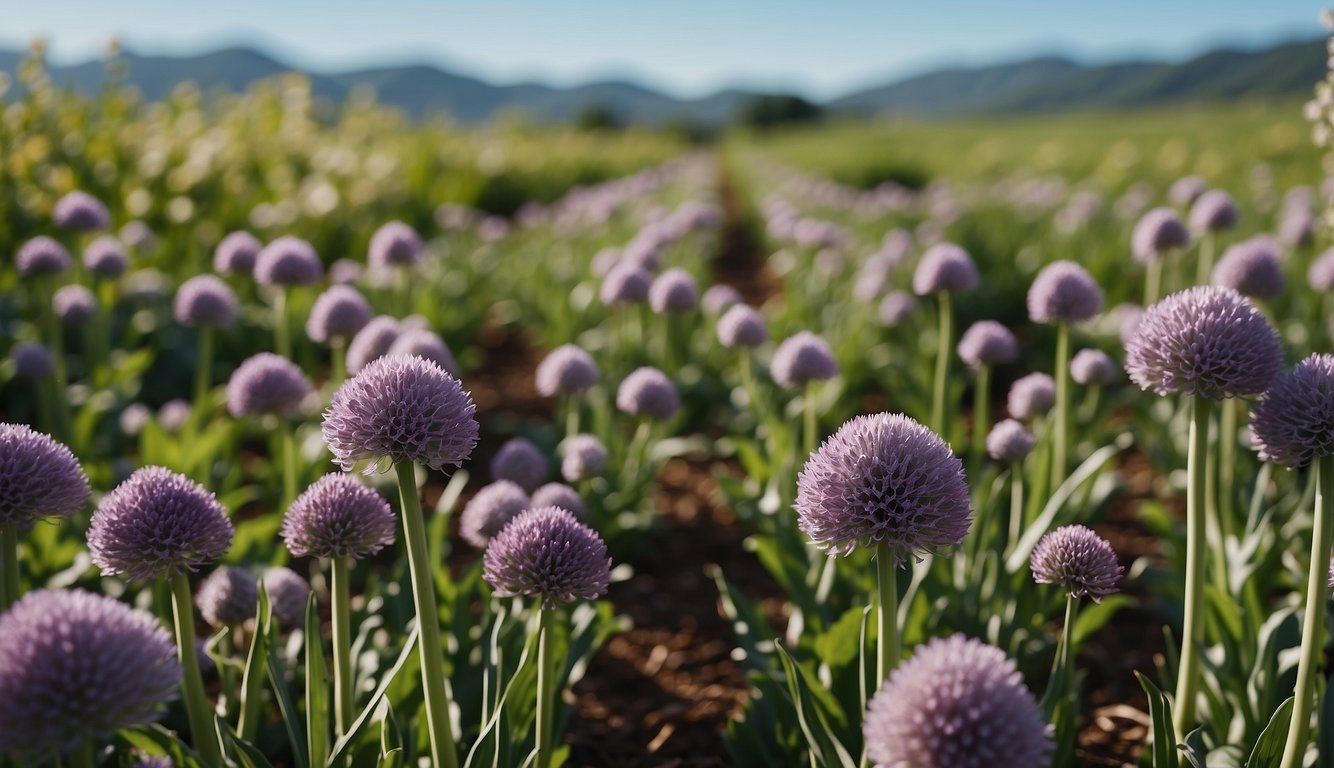
It’s important to consider the regional factors that can affect the growth and yield of your garlic crop. In this section, I will discuss two important regional considerations: garlic in different climates and local garlic varieties.
Garlic Garden in Different Climates
Garlic is a versatile crop that can be grown in a variety of climates. However, different climates can affect the growth and yield of garlic. In general, garlic grows best in regions with cool and dry climates.
If you live in the northern regions of the United States or Asia, you can grow hardneck garlic varieties such as the Chinese Purple or the Red ‘Music’ garlic. These varieties are adapted to colder climates and can withstand harsh winters. On the other hand, if you live in the southern regions of the United States or Asia, you can grow softneck garlic varieties such as the Chinese White or the California Early garlic. These varieties are adapted to warmer climates and can grow well in milder winters.
Local Garlic Varieties
When it comes to garlic gardening, it is always best to choose local garlic varieties. Local garlic varieties are adapted to the local climate and soil conditions, and they can grow better than non-local varieties.
For example, if you live in China, you can grow the Chinese Purple or the Red ‘Music’ garlic, which are popular local varieties. These varieties are adapted to the local climate and soil conditions, and they can grow well in your region. Similarly, if you live in the United States, you can grow local garlic varieties such as the California Early or the Texas White garlic, which are adapted to the local climate and soil conditions.
Regional considerations are important when it comes to garlic gardening. By considering the climate and local garlic varieties, you can maximize the growth and yield of your garlic crop.
Garlic Garden: A Flavorful Journey with TheHerbProf.com
Today, we’re digging into the world of Garlic Gardens. These aromatic plots can transform your backyard into a gourmet paradise!
First up, The Plot. A garlic garden starts with a sunny spot and well-drained soil. And guess what? TheHerbProf.com has a detailed guide on preparing your garden plot. It’s like having a personal garden architect!
Next, the Planting stage. Garlic is planted in the fall for a summer harvest. And TheHerbProf.com? It’s got all the info you need to plant your garlic at the right time. It’s a gardener’s dream!
Then there’s the Care stage. Your garlic will need some TLC to grow big and strong. And with TheHerbProf.com, you’ve got a guide to caring for your garlic garden. It’s like a DIY project for your backyard!
In short, Garlic Gardens and TheHerbProf.com are a match made in garden heaven. They offer a blend of practical gardening advice and fascinating plant facts. So, whether you’re a garlic enthusiast or a green newbie, there’s always something new to learn!
Remember, folks, a garlic garden is a joy forever. Keep exploring TheHerbProf.com for more green adventures, you can check our homepage here!
References – Garlic Garden
Little Herb Encyclopedia, by Jack Ritchason; N.D., Woodland Publishing Incorporated, 1995
The Ultimate Healing System, Course Manual, Copyright 1985, Don Lepore
Planetary Herbology, Michael Tierra, C.A., N.D., Lotus Press, 1988
Handbook of Medicinal Herbs, by James A. Duke, Pub. CRP Second Edition 2007
The Complete Medicinal Herbal, by Penelope Ody, Published by Dorling Kindersley
Check the Following Articles!
Insomnia and Sleep Disorders: Symptoms & Treatments
Roasted Garlic in Air Fryer: A Simple and Delicious Recipe
Garlic Potato Recipe: A Flavorful and Easy Side Dish
Spanish Garlic: A Flavorful Addition to Your Kitchen
Frequently Asked Questions – Garlic Garden
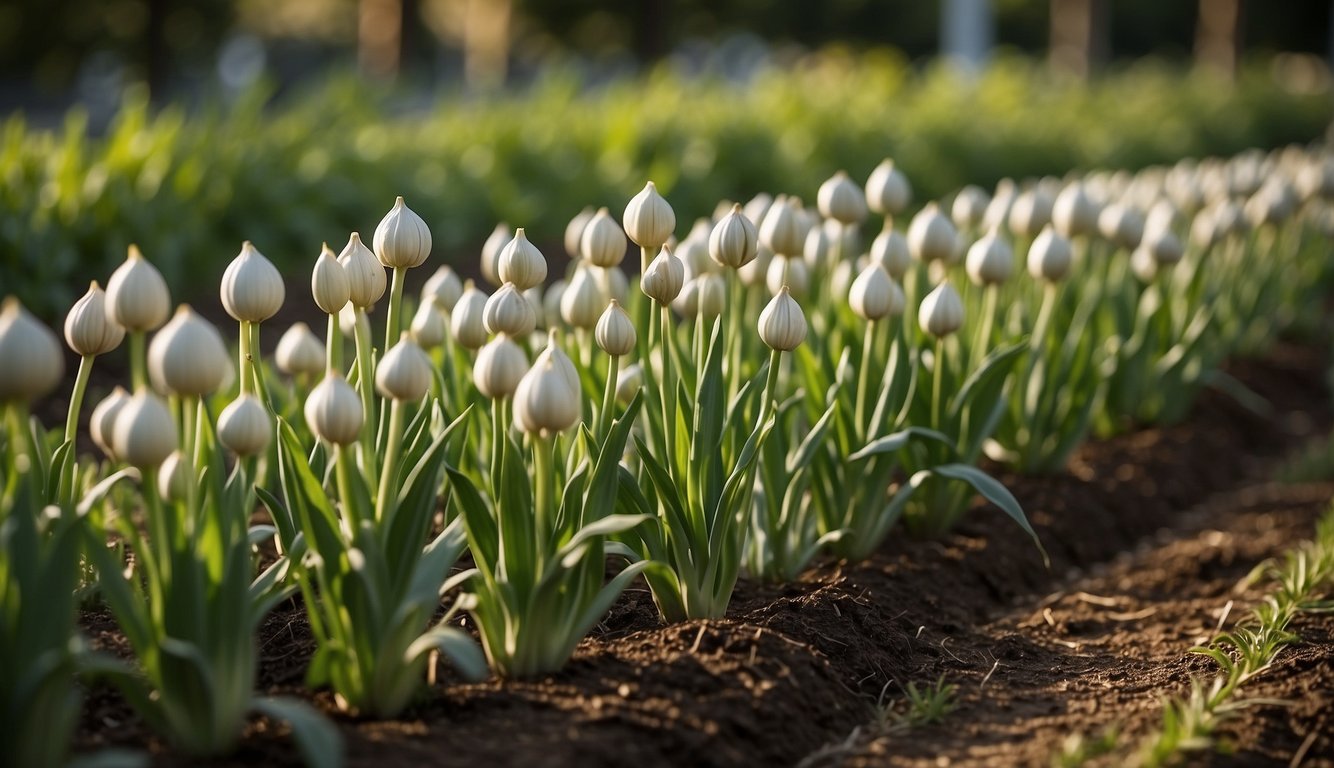
What are the best companion plants for garlic?
Garlic can benefit from being planted with certain companion plants, such as onions, chives, and shallots. These plants are all part of the Allium family and can help deter pests and improve the soil quality. Other good companion plants for garlic include spinach, lettuce, and other leafy greens.
What are the steps for growing garlic in containers?
Growing garlic in containers is a great option for those with limited space or poor soil quality. To grow garlic in containers, you will need a container that is at least 6-8 inches deep and wide enough to accommodate the bulbs. Fill the container with well-draining soil and plant the garlic cloves about 2-3 inches deep with the pointed end facing up. Water the soil regularly and keep the container in a sunny location.
What is the ideal depth for planting garlic cloves?
The ideal depth for planting garlic cloves is about 2-3 inches deep with the pointed end facing up. Planting the cloves too shallow or too deep can affect the growth and yield of the garlic.
How can you successfully grow garlic indoors?
Growing garlic indoors is possible, but it requires a few extra steps. You will need to provide adequate lighting and temperature control to mimic the outdoor growing conditions. Plant the garlic cloves in a container filled with well-draining soil and place it in a sunny location. Water the soil regularly and provide additional lighting if necessary.
What is the typical growth duration for garlic from planting to harvest?
The typical growth duration for garlic from planting to harvest is about 8-9 months. Garlic is planted in the fall and harvested in the summer when the leaves start to turn brown.
What are common mistakes to avoid when planting garlic?
Common mistakes to avoid when planting garlic include planting the cloves too shallow or too deep, not providing enough water or sunlight, and planting too close together. It is also important to avoid planting garlic in soil that is too wet or has poor drainage.
